Literature Review: IT Industry in Australia - Analysis
VerifiedAdded on 2020/03/13
|11
|2735
|168
Literature Review
AI Summary
This literature review provides an in-depth analysis of the IT industry in Australia, examining its growth, associated issues, and challenges. The study utilizes secondary data from various sources, including books, journals, and research articles, to present a critical understanding of the sector. The review highlights the slow development of the Australian IT market compared to leading countries and discusses the skill shortages and competition for IT jobs. It explores the challenges faced by the IT sector, such as cash flow issues, the need for innovation, and the impact of overseas expansion. The review also discusses the future of IT in Australia, including the growth of the app economy and the importance of e-business and e-solutions. The analysis concludes that the Australian IT industry has not significantly contributed to the country's economic development, and the sector faces several issues that have impacted its growth, but new possibilities are emerging that, if addressed properly, could help the industry succeed.
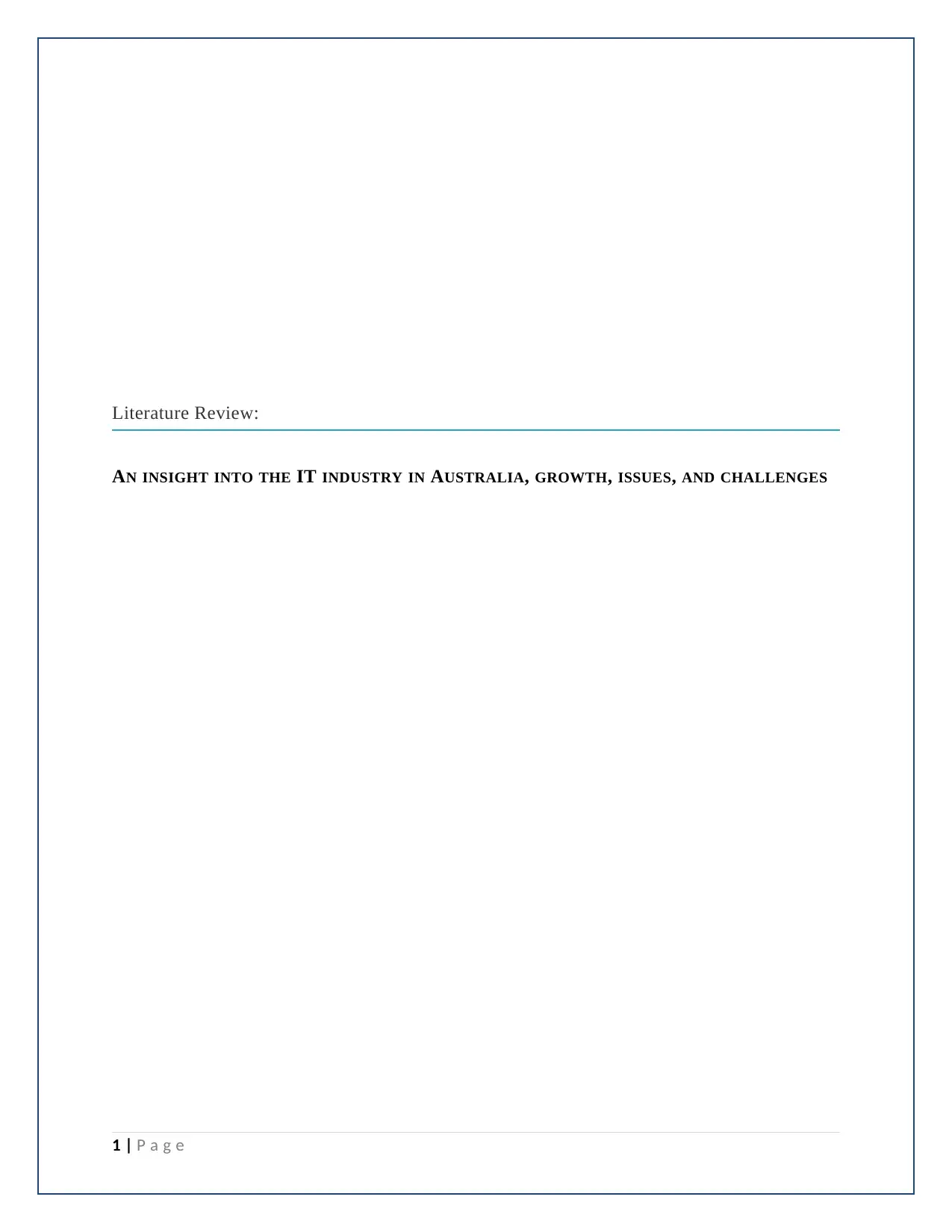
Literature Review:
AN INSIGHT INTO THE IT INDUSTRY IN AUSTRALIA, GROWTH, ISSUES, AND CHALLENGES
1 | P a g e
AN INSIGHT INTO THE IT INDUSTRY IN AUSTRALIA, GROWTH, ISSUES, AND CHALLENGES
1 | P a g e
Paraphrase This Document
Need a fresh take? Get an instant paraphrase of this document with our AI Paraphraser
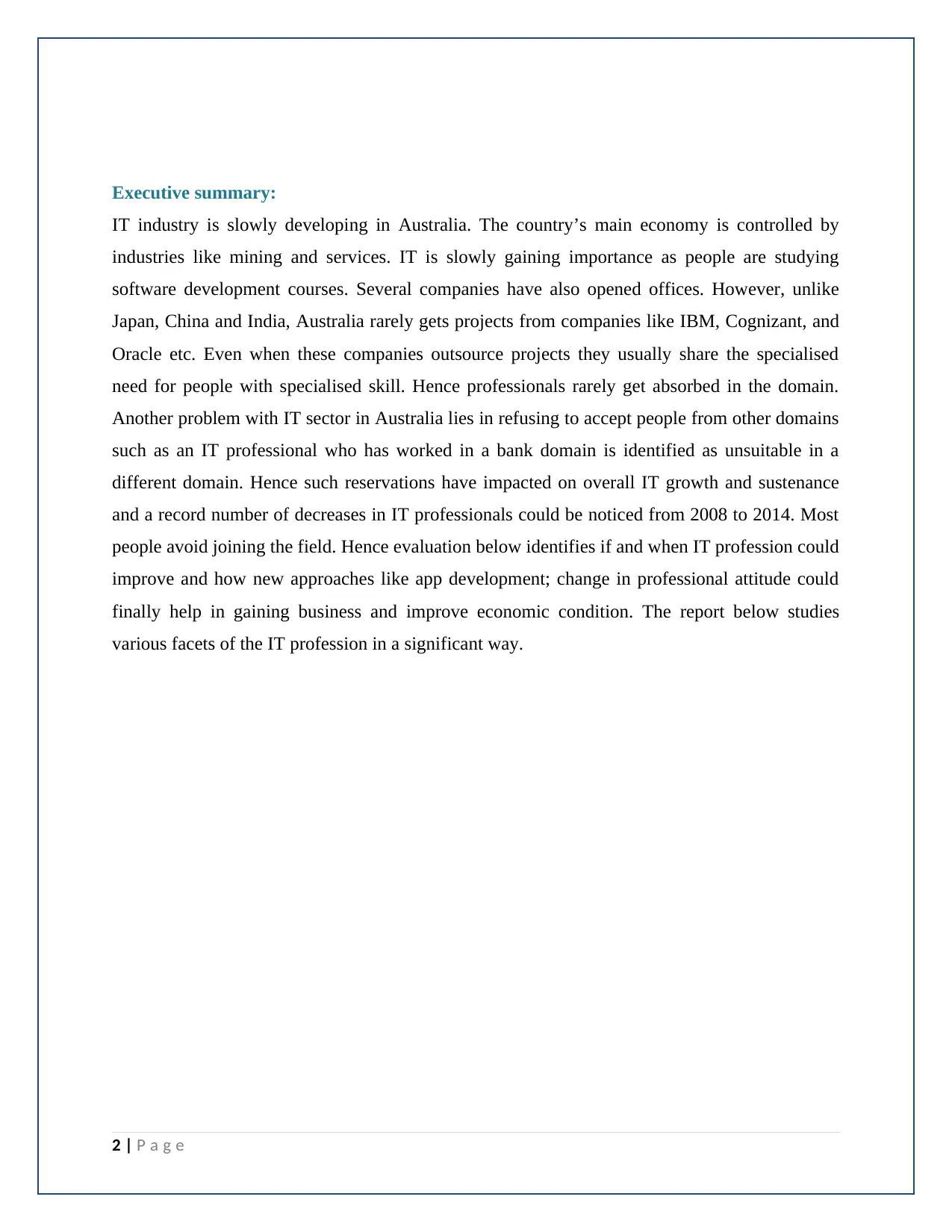
Executive summary:
IT industry is slowly developing in Australia. The country’s main economy is controlled by
industries like mining and services. IT is slowly gaining importance as people are studying
software development courses. Several companies have also opened offices. However, unlike
Japan, China and India, Australia rarely gets projects from companies like IBM, Cognizant, and
Oracle etc. Even when these companies outsource projects they usually share the specialised
need for people with specialised skill. Hence professionals rarely get absorbed in the domain.
Another problem with IT sector in Australia lies in refusing to accept people from other domains
such as an IT professional who has worked in a bank domain is identified as unsuitable in a
different domain. Hence such reservations have impacted on overall IT growth and sustenance
and a record number of decreases in IT professionals could be noticed from 2008 to 2014. Most
people avoid joining the field. Hence evaluation below identifies if and when IT profession could
improve and how new approaches like app development; change in professional attitude could
finally help in gaining business and improve economic condition. The report below studies
various facets of the IT profession in a significant way.
2 | P a g e
IT industry is slowly developing in Australia. The country’s main economy is controlled by
industries like mining and services. IT is slowly gaining importance as people are studying
software development courses. Several companies have also opened offices. However, unlike
Japan, China and India, Australia rarely gets projects from companies like IBM, Cognizant, and
Oracle etc. Even when these companies outsource projects they usually share the specialised
need for people with specialised skill. Hence professionals rarely get absorbed in the domain.
Another problem with IT sector in Australia lies in refusing to accept people from other domains
such as an IT professional who has worked in a bank domain is identified as unsuitable in a
different domain. Hence such reservations have impacted on overall IT growth and sustenance
and a record number of decreases in IT professionals could be noticed from 2008 to 2014. Most
people avoid joining the field. Hence evaluation below identifies if and when IT profession could
improve and how new approaches like app development; change in professional attitude could
finally help in gaining business and improve economic condition. The report below studies
various facets of the IT profession in a significant way.
2 | P a g e
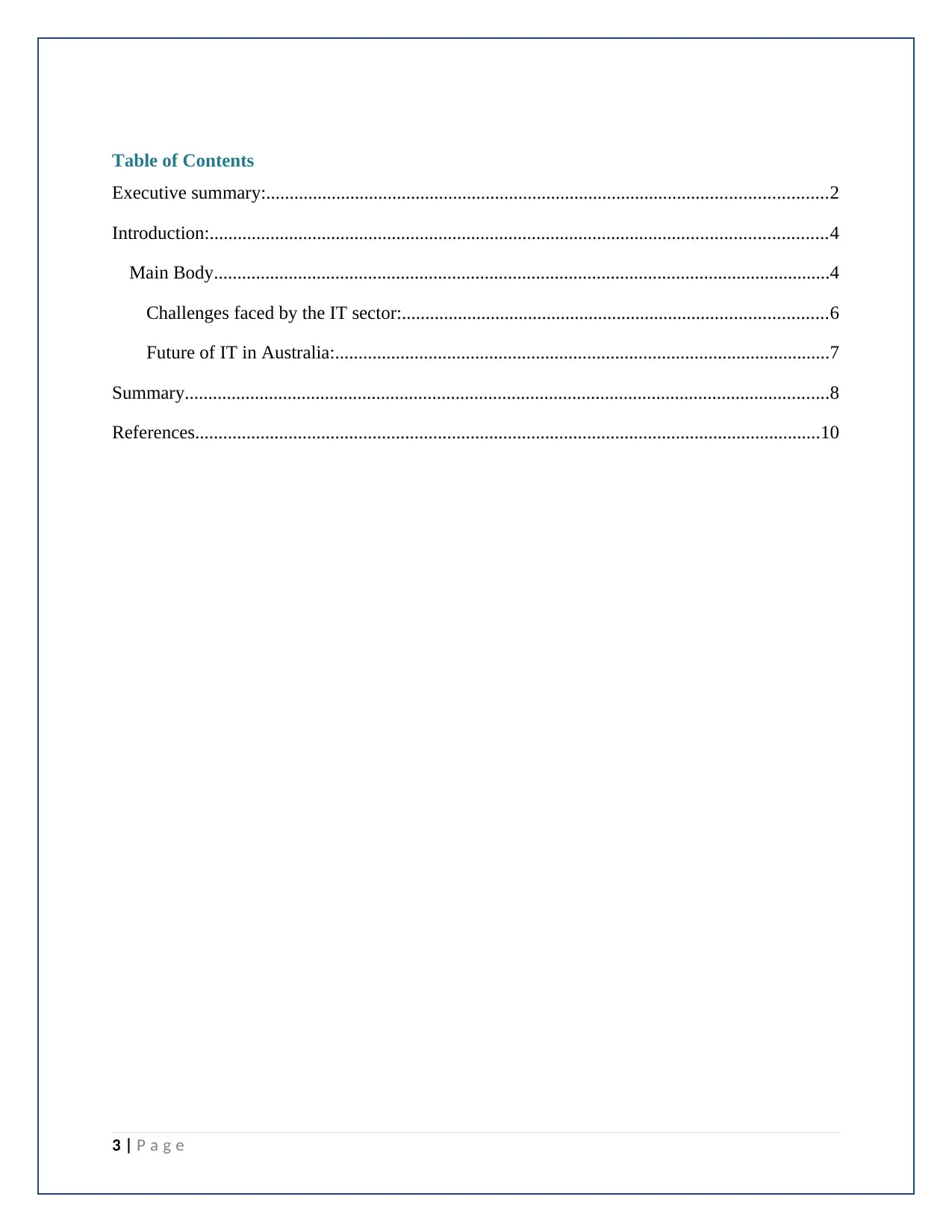
Table of Contents
Executive summary:........................................................................................................................2
Introduction:....................................................................................................................................4
Main Body....................................................................................................................................4
Challenges faced by the IT sector:...........................................................................................6
Future of IT in Australia:..........................................................................................................7
Summary..........................................................................................................................................8
References......................................................................................................................................10
3 | P a g e
Executive summary:........................................................................................................................2
Introduction:....................................................................................................................................4
Main Body....................................................................................................................................4
Challenges faced by the IT sector:...........................................................................................6
Future of IT in Australia:..........................................................................................................7
Summary..........................................................................................................................................8
References......................................................................................................................................10
3 | P a g e
⊘ This is a preview!⊘
Do you want full access?
Subscribe today to unlock all pages.

Trusted by 1+ million students worldwide
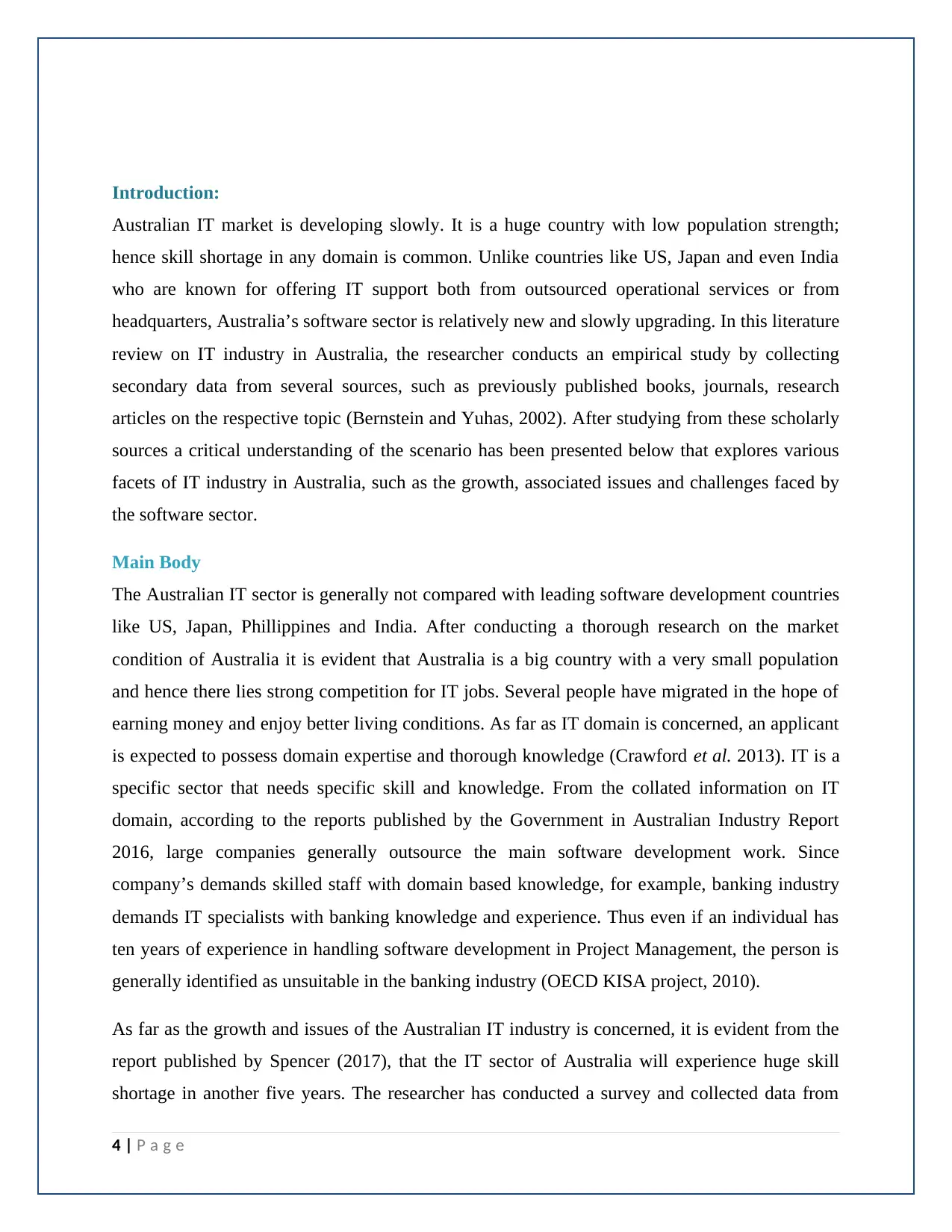
Introduction:
Australian IT market is developing slowly. It is a huge country with low population strength;
hence skill shortage in any domain is common. Unlike countries like US, Japan and even India
who are known for offering IT support both from outsourced operational services or from
headquarters, Australia’s software sector is relatively new and slowly upgrading. In this literature
review on IT industry in Australia, the researcher conducts an empirical study by collecting
secondary data from several sources, such as previously published books, journals, research
articles on the respective topic (Bernstein and Yuhas, 2002). After studying from these scholarly
sources a critical understanding of the scenario has been presented below that explores various
facets of IT industry in Australia, such as the growth, associated issues and challenges faced by
the software sector.
Main Body
The Australian IT sector is generally not compared with leading software development countries
like US, Japan, Phillippines and India. After conducting a thorough research on the market
condition of Australia it is evident that Australia is a big country with a very small population
and hence there lies strong competition for IT jobs. Several people have migrated in the hope of
earning money and enjoy better living conditions. As far as IT domain is concerned, an applicant
is expected to possess domain expertise and thorough knowledge (Crawford et al. 2013). IT is a
specific sector that needs specific skill and knowledge. From the collated information on IT
domain, according to the reports published by the Government in Australian Industry Report
2016, large companies generally outsource the main software development work. Since
company’s demands skilled staff with domain based knowledge, for example, banking industry
demands IT specialists with banking knowledge and experience. Thus even if an individual has
ten years of experience in handling software development in Project Management, the person is
generally identified as unsuitable in the banking industry (OECD KISA project, 2010).
As far as the growth and issues of the Australian IT industry is concerned, it is evident from the
report published by Spencer (2017), that the IT sector of Australia will experience huge skill
shortage in another five years. The researcher has conducted a survey and collected data from
4 | P a g e
Australian IT market is developing slowly. It is a huge country with low population strength;
hence skill shortage in any domain is common. Unlike countries like US, Japan and even India
who are known for offering IT support both from outsourced operational services or from
headquarters, Australia’s software sector is relatively new and slowly upgrading. In this literature
review on IT industry in Australia, the researcher conducts an empirical study by collecting
secondary data from several sources, such as previously published books, journals, research
articles on the respective topic (Bernstein and Yuhas, 2002). After studying from these scholarly
sources a critical understanding of the scenario has been presented below that explores various
facets of IT industry in Australia, such as the growth, associated issues and challenges faced by
the software sector.
Main Body
The Australian IT sector is generally not compared with leading software development countries
like US, Japan, Phillippines and India. After conducting a thorough research on the market
condition of Australia it is evident that Australia is a big country with a very small population
and hence there lies strong competition for IT jobs. Several people have migrated in the hope of
earning money and enjoy better living conditions. As far as IT domain is concerned, an applicant
is expected to possess domain expertise and thorough knowledge (Crawford et al. 2013). IT is a
specific sector that needs specific skill and knowledge. From the collated information on IT
domain, according to the reports published by the Government in Australian Industry Report
2016, large companies generally outsource the main software development work. Since
company’s demands skilled staff with domain based knowledge, for example, banking industry
demands IT specialists with banking knowledge and experience. Thus even if an individual has
ten years of experience in handling software development in Project Management, the person is
generally identified as unsuitable in the banking industry (OECD KISA project, 2010).
As far as the growth and issues of the Australian IT industry is concerned, it is evident from the
report published by Spencer (2017), that the IT sector of Australia will experience huge skill
shortage in another five years. The researcher has conducted a survey and collected data from
4 | P a g e
Paraphrase This Document
Need a fresh take? Get an instant paraphrase of this document with our AI Paraphraser
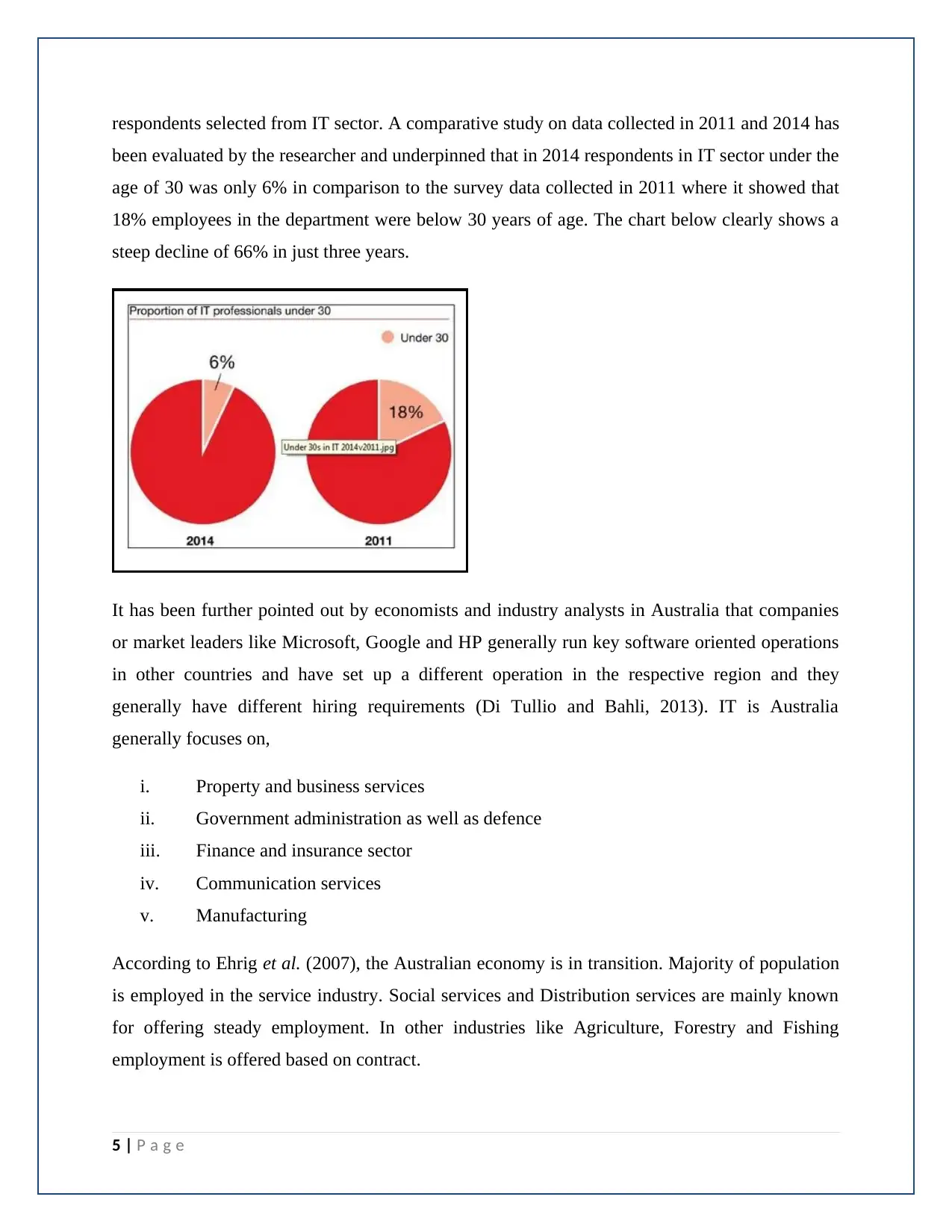
respondents selected from IT sector. A comparative study on data collected in 2011 and 2014 has
been evaluated by the researcher and underpinned that in 2014 respondents in IT sector under the
age of 30 was only 6% in comparison to the survey data collected in 2011 where it showed that
18% employees in the department were below 30 years of age. The chart below clearly shows a
steep decline of 66% in just three years.
It has been further pointed out by economists and industry analysts in Australia that companies
or market leaders like Microsoft, Google and HP generally run key software oriented operations
in other countries and have set up a different operation in the respective region and they
generally have different hiring requirements (Di Tullio and Bahli, 2013). IT is Australia
generally focuses on,
i. Property and business services
ii. Government administration as well as defence
iii. Finance and insurance sector
iv. Communication services
v. Manufacturing
According to Ehrig et al. (2007), the Australian economy is in transition. Majority of population
is employed in the service industry. Social services and Distribution services are mainly known
for offering steady employment. In other industries like Agriculture, Forestry and Fishing
employment is offered based on contract.
5 | P a g e
been evaluated by the researcher and underpinned that in 2014 respondents in IT sector under the
age of 30 was only 6% in comparison to the survey data collected in 2011 where it showed that
18% employees in the department were below 30 years of age. The chart below clearly shows a
steep decline of 66% in just three years.
It has been further pointed out by economists and industry analysts in Australia that companies
or market leaders like Microsoft, Google and HP generally run key software oriented operations
in other countries and have set up a different operation in the respective region and they
generally have different hiring requirements (Di Tullio and Bahli, 2013). IT is Australia
generally focuses on,
i. Property and business services
ii. Government administration as well as defence
iii. Finance and insurance sector
iv. Communication services
v. Manufacturing
According to Ehrig et al. (2007), the Australian economy is in transition. Majority of population
is employed in the service industry. Social services and Distribution services are mainly known
for offering steady employment. In other industries like Agriculture, Forestry and Fishing
employment is offered based on contract.
5 | P a g e
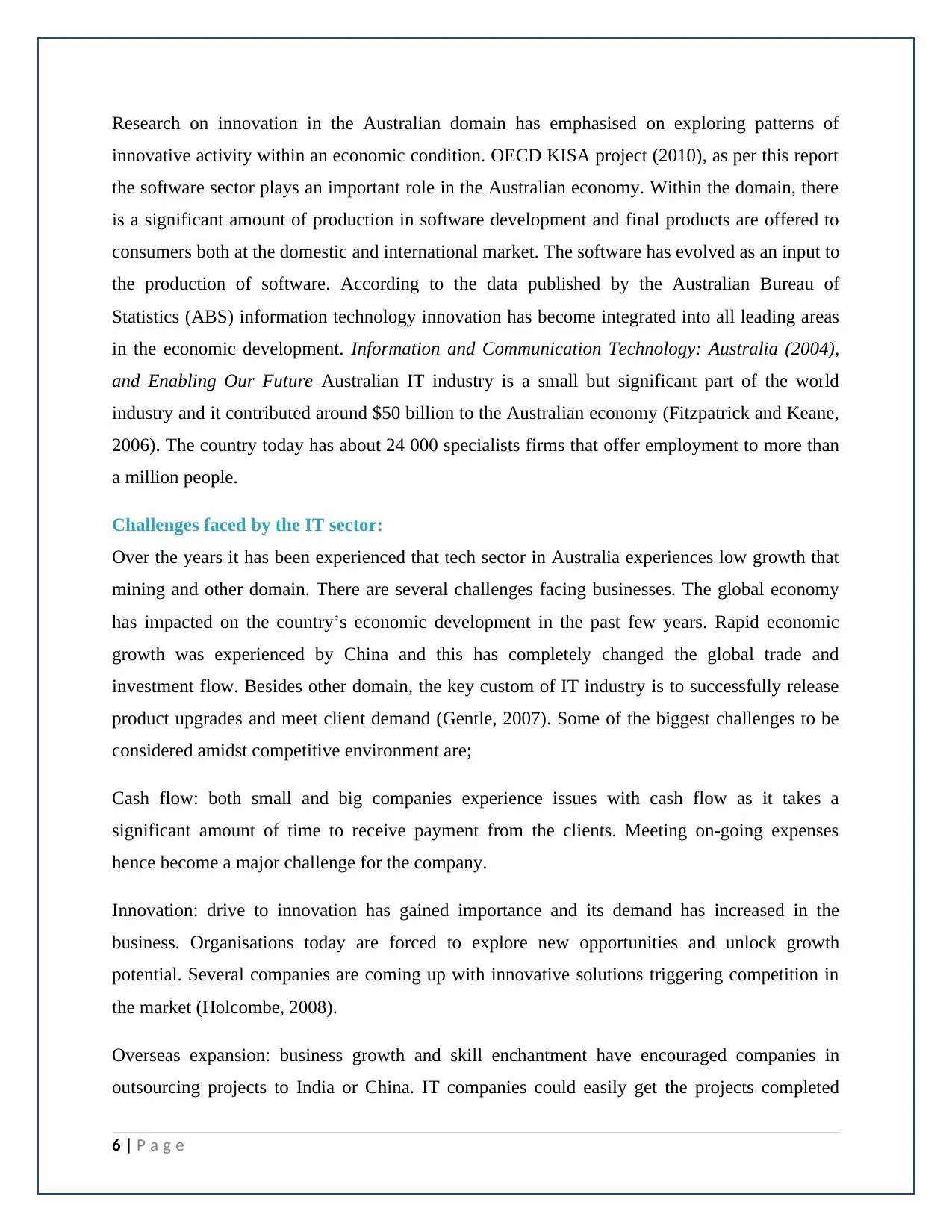
Research on innovation in the Australian domain has emphasised on exploring patterns of
innovative activity within an economic condition. OECD KISA project (2010), as per this report
the software sector plays an important role in the Australian economy. Within the domain, there
is a significant amount of production in software development and final products are offered to
consumers both at the domestic and international market. The software has evolved as an input to
the production of software. According to the data published by the Australian Bureau of
Statistics (ABS) information technology innovation has become integrated into all leading areas
in the economic development. Information and Communication Technology: Australia (2004),
and Enabling Our Future Australian IT industry is a small but significant part of the world
industry and it contributed around $50 billion to the Australian economy (Fitzpatrick and Keane,
2006). The country today has about 24 000 specialists firms that offer employment to more than
a million people.
Challenges faced by the IT sector:
Over the years it has been experienced that tech sector in Australia experiences low growth that
mining and other domain. There are several challenges facing businesses. The global economy
has impacted on the country’s economic development in the past few years. Rapid economic
growth was experienced by China and this has completely changed the global trade and
investment flow. Besides other domain, the key custom of IT industry is to successfully release
product upgrades and meet client demand (Gentle, 2007). Some of the biggest challenges to be
considered amidst competitive environment are;
Cash flow: both small and big companies experience issues with cash flow as it takes a
significant amount of time to receive payment from the clients. Meeting on-going expenses
hence become a major challenge for the company.
Innovation: drive to innovation has gained importance and its demand has increased in the
business. Organisations today are forced to explore new opportunities and unlock growth
potential. Several companies are coming up with innovative solutions triggering competition in
the market (Holcombe, 2008).
Overseas expansion: business growth and skill enchantment have encouraged companies in
outsourcing projects to India or China. IT companies could easily get the projects completed
6 | P a g e
innovative activity within an economic condition. OECD KISA project (2010), as per this report
the software sector plays an important role in the Australian economy. Within the domain, there
is a significant amount of production in software development and final products are offered to
consumers both at the domestic and international market. The software has evolved as an input to
the production of software. According to the data published by the Australian Bureau of
Statistics (ABS) information technology innovation has become integrated into all leading areas
in the economic development. Information and Communication Technology: Australia (2004),
and Enabling Our Future Australian IT industry is a small but significant part of the world
industry and it contributed around $50 billion to the Australian economy (Fitzpatrick and Keane,
2006). The country today has about 24 000 specialists firms that offer employment to more than
a million people.
Challenges faced by the IT sector:
Over the years it has been experienced that tech sector in Australia experiences low growth that
mining and other domain. There are several challenges facing businesses. The global economy
has impacted on the country’s economic development in the past few years. Rapid economic
growth was experienced by China and this has completely changed the global trade and
investment flow. Besides other domain, the key custom of IT industry is to successfully release
product upgrades and meet client demand (Gentle, 2007). Some of the biggest challenges to be
considered amidst competitive environment are;
Cash flow: both small and big companies experience issues with cash flow as it takes a
significant amount of time to receive payment from the clients. Meeting on-going expenses
hence become a major challenge for the company.
Innovation: drive to innovation has gained importance and its demand has increased in the
business. Organisations today are forced to explore new opportunities and unlock growth
potential. Several companies are coming up with innovative solutions triggering competition in
the market (Holcombe, 2008).
Overseas expansion: business growth and skill enchantment have encouraged companies in
outsourcing projects to India or China. IT companies could easily get the projects completed
6 | P a g e
⊘ This is a preview!⊘
Do you want full access?
Subscribe today to unlock all pages.

Trusted by 1+ million students worldwide
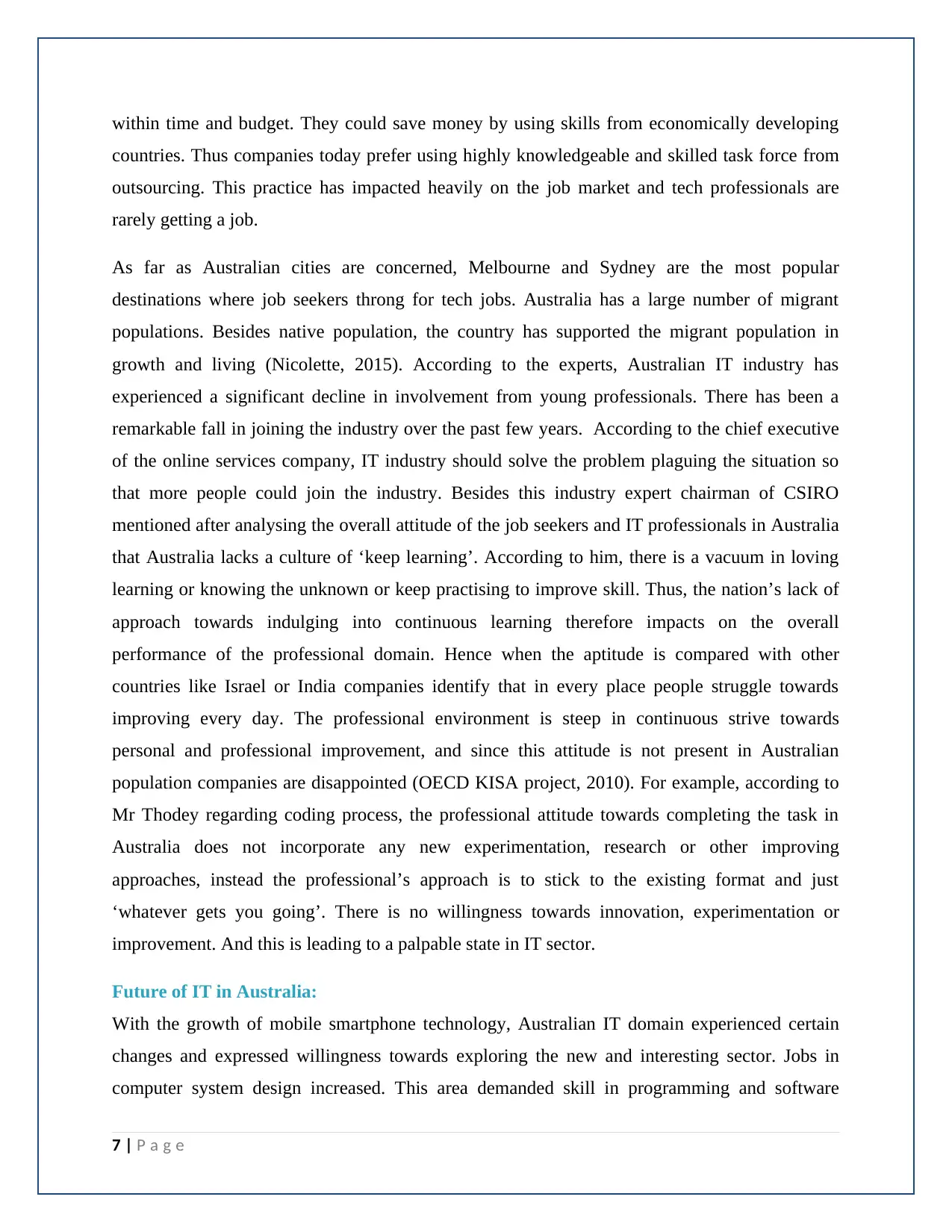
within time and budget. They could save money by using skills from economically developing
countries. Thus companies today prefer using highly knowledgeable and skilled task force from
outsourcing. This practice has impacted heavily on the job market and tech professionals are
rarely getting a job.
As far as Australian cities are concerned, Melbourne and Sydney are the most popular
destinations where job seekers throng for tech jobs. Australia has a large number of migrant
populations. Besides native population, the country has supported the migrant population in
growth and living (Nicolette, 2015). According to the experts, Australian IT industry has
experienced a significant decline in involvement from young professionals. There has been a
remarkable fall in joining the industry over the past few years. According to the chief executive
of the online services company, IT industry should solve the problem plaguing the situation so
that more people could join the industry. Besides this industry expert chairman of CSIRO
mentioned after analysing the overall attitude of the job seekers and IT professionals in Australia
that Australia lacks a culture of ‘keep learning’. According to him, there is a vacuum in loving
learning or knowing the unknown or keep practising to improve skill. Thus, the nation’s lack of
approach towards indulging into continuous learning therefore impacts on the overall
performance of the professional domain. Hence when the aptitude is compared with other
countries like Israel or India companies identify that in every place people struggle towards
improving every day. The professional environment is steep in continuous strive towards
personal and professional improvement, and since this attitude is not present in Australian
population companies are disappointed (OECD KISA project, 2010). For example, according to
Mr Thodey regarding coding process, the professional attitude towards completing the task in
Australia does not incorporate any new experimentation, research or other improving
approaches, instead the professional’s approach is to stick to the existing format and just
‘whatever gets you going’. There is no willingness towards innovation, experimentation or
improvement. And this is leading to a palpable state in IT sector.
Future of IT in Australia:
With the growth of mobile smartphone technology, Australian IT domain experienced certain
changes and expressed willingness towards exploring the new and interesting sector. Jobs in
computer system design increased. This area demanded skill in programming and software
7 | P a g e
countries. Thus companies today prefer using highly knowledgeable and skilled task force from
outsourcing. This practice has impacted heavily on the job market and tech professionals are
rarely getting a job.
As far as Australian cities are concerned, Melbourne and Sydney are the most popular
destinations where job seekers throng for tech jobs. Australia has a large number of migrant
populations. Besides native population, the country has supported the migrant population in
growth and living (Nicolette, 2015). According to the experts, Australian IT industry has
experienced a significant decline in involvement from young professionals. There has been a
remarkable fall in joining the industry over the past few years. According to the chief executive
of the online services company, IT industry should solve the problem plaguing the situation so
that more people could join the industry. Besides this industry expert chairman of CSIRO
mentioned after analysing the overall attitude of the job seekers and IT professionals in Australia
that Australia lacks a culture of ‘keep learning’. According to him, there is a vacuum in loving
learning or knowing the unknown or keep practising to improve skill. Thus, the nation’s lack of
approach towards indulging into continuous learning therefore impacts on the overall
performance of the professional domain. Hence when the aptitude is compared with other
countries like Israel or India companies identify that in every place people struggle towards
improving every day. The professional environment is steep in continuous strive towards
personal and professional improvement, and since this attitude is not present in Australian
population companies are disappointed (OECD KISA project, 2010). For example, according to
Mr Thodey regarding coding process, the professional attitude towards completing the task in
Australia does not incorporate any new experimentation, research or other improving
approaches, instead the professional’s approach is to stick to the existing format and just
‘whatever gets you going’. There is no willingness towards innovation, experimentation or
improvement. And this is leading to a palpable state in IT sector.
Future of IT in Australia:
With the growth of mobile smartphone technology, Australian IT domain experienced certain
changes and expressed willingness towards exploring the new and interesting sector. Jobs in
computer system design increased. This area demanded skill in programming and software
7 | P a g e
Paraphrase This Document
Need a fresh take? Get an instant paraphrase of this document with our AI Paraphraser
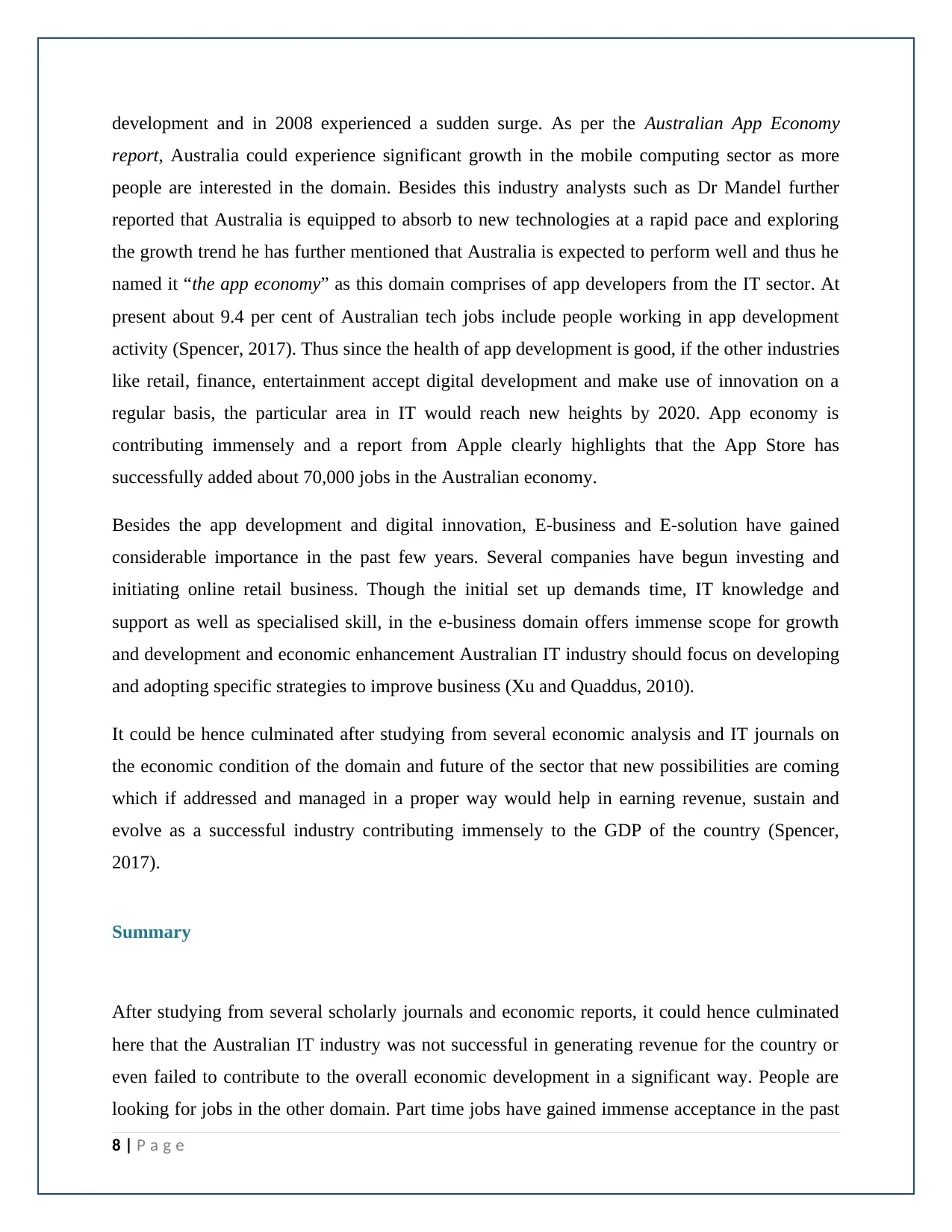
development and in 2008 experienced a sudden surge. As per the Australian App Economy
report, Australia could experience significant growth in the mobile computing sector as more
people are interested in the domain. Besides this industry analysts such as Dr Mandel further
reported that Australia is equipped to absorb to new technologies at a rapid pace and exploring
the growth trend he has further mentioned that Australia is expected to perform well and thus he
named it “the app economy” as this domain comprises of app developers from the IT sector. At
present about 9.4 per cent of Australian tech jobs include people working in app development
activity (Spencer, 2017). Thus since the health of app development is good, if the other industries
like retail, finance, entertainment accept digital development and make use of innovation on a
regular basis, the particular area in IT would reach new heights by 2020. App economy is
contributing immensely and a report from Apple clearly highlights that the App Store has
successfully added about 70,000 jobs in the Australian economy.
Besides the app development and digital innovation, E-business and E-solution have gained
considerable importance in the past few years. Several companies have begun investing and
initiating online retail business. Though the initial set up demands time, IT knowledge and
support as well as specialised skill, in the e-business domain offers immense scope for growth
and development and economic enhancement Australian IT industry should focus on developing
and adopting specific strategies to improve business (Xu and Quaddus, 2010).
It could be hence culminated after studying from several economic analysis and IT journals on
the economic condition of the domain and future of the sector that new possibilities are coming
which if addressed and managed in a proper way would help in earning revenue, sustain and
evolve as a successful industry contributing immensely to the GDP of the country (Spencer,
2017).
Summary
After studying from several scholarly journals and economic reports, it could hence culminated
here that the Australian IT industry was not successful in generating revenue for the country or
even failed to contribute to the overall economic development in a significant way. People are
looking for jobs in the other domain. Part time jobs have gained immense acceptance in the past
8 | P a g e
report, Australia could experience significant growth in the mobile computing sector as more
people are interested in the domain. Besides this industry analysts such as Dr Mandel further
reported that Australia is equipped to absorb to new technologies at a rapid pace and exploring
the growth trend he has further mentioned that Australia is expected to perform well and thus he
named it “the app economy” as this domain comprises of app developers from the IT sector. At
present about 9.4 per cent of Australian tech jobs include people working in app development
activity (Spencer, 2017). Thus since the health of app development is good, if the other industries
like retail, finance, entertainment accept digital development and make use of innovation on a
regular basis, the particular area in IT would reach new heights by 2020. App economy is
contributing immensely and a report from Apple clearly highlights that the App Store has
successfully added about 70,000 jobs in the Australian economy.
Besides the app development and digital innovation, E-business and E-solution have gained
considerable importance in the past few years. Several companies have begun investing and
initiating online retail business. Though the initial set up demands time, IT knowledge and
support as well as specialised skill, in the e-business domain offers immense scope for growth
and development and economic enhancement Australian IT industry should focus on developing
and adopting specific strategies to improve business (Xu and Quaddus, 2010).
It could be hence culminated after studying from several economic analysis and IT journals on
the economic condition of the domain and future of the sector that new possibilities are coming
which if addressed and managed in a proper way would help in earning revenue, sustain and
evolve as a successful industry contributing immensely to the GDP of the country (Spencer,
2017).
Summary
After studying from several scholarly journals and economic reports, it could hence culminated
here that the Australian IT industry was not successful in generating revenue for the country or
even failed to contribute to the overall economic development in a significant way. People are
looking for jobs in the other domain. Part time jobs have gained immense acceptance in the past
8 | P a g e
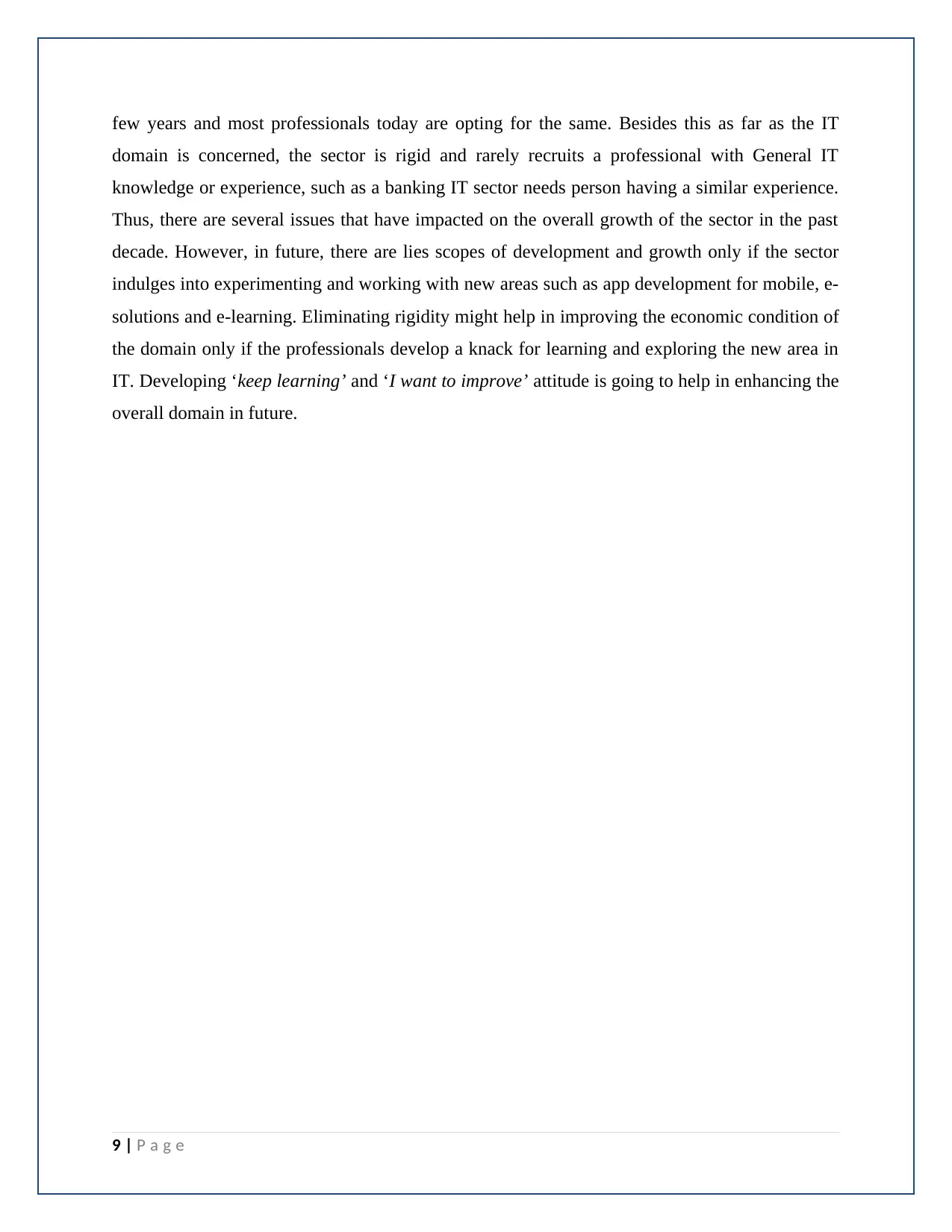
few years and most professionals today are opting for the same. Besides this as far as the IT
domain is concerned, the sector is rigid and rarely recruits a professional with General IT
knowledge or experience, such as a banking IT sector needs person having a similar experience.
Thus, there are several issues that have impacted on the overall growth of the sector in the past
decade. However, in future, there are lies scopes of development and growth only if the sector
indulges into experimenting and working with new areas such as app development for mobile, e-
solutions and e-learning. Eliminating rigidity might help in improving the economic condition of
the domain only if the professionals develop a knack for learning and exploring the new area in
IT. Developing ‘keep learning’ and ‘I want to improve’ attitude is going to help in enhancing the
overall domain in future.
9 | P a g e
domain is concerned, the sector is rigid and rarely recruits a professional with General IT
knowledge or experience, such as a banking IT sector needs person having a similar experience.
Thus, there are several issues that have impacted on the overall growth of the sector in the past
decade. However, in future, there are lies scopes of development and growth only if the sector
indulges into experimenting and working with new areas such as app development for mobile, e-
solutions and e-learning. Eliminating rigidity might help in improving the economic condition of
the domain only if the professionals develop a knack for learning and exploring the new area in
IT. Developing ‘keep learning’ and ‘I want to improve’ attitude is going to help in enhancing the
overall domain in future.
9 | P a g e
⊘ This is a preview!⊘
Do you want full access?
Subscribe today to unlock all pages.

Trusted by 1+ million students worldwide
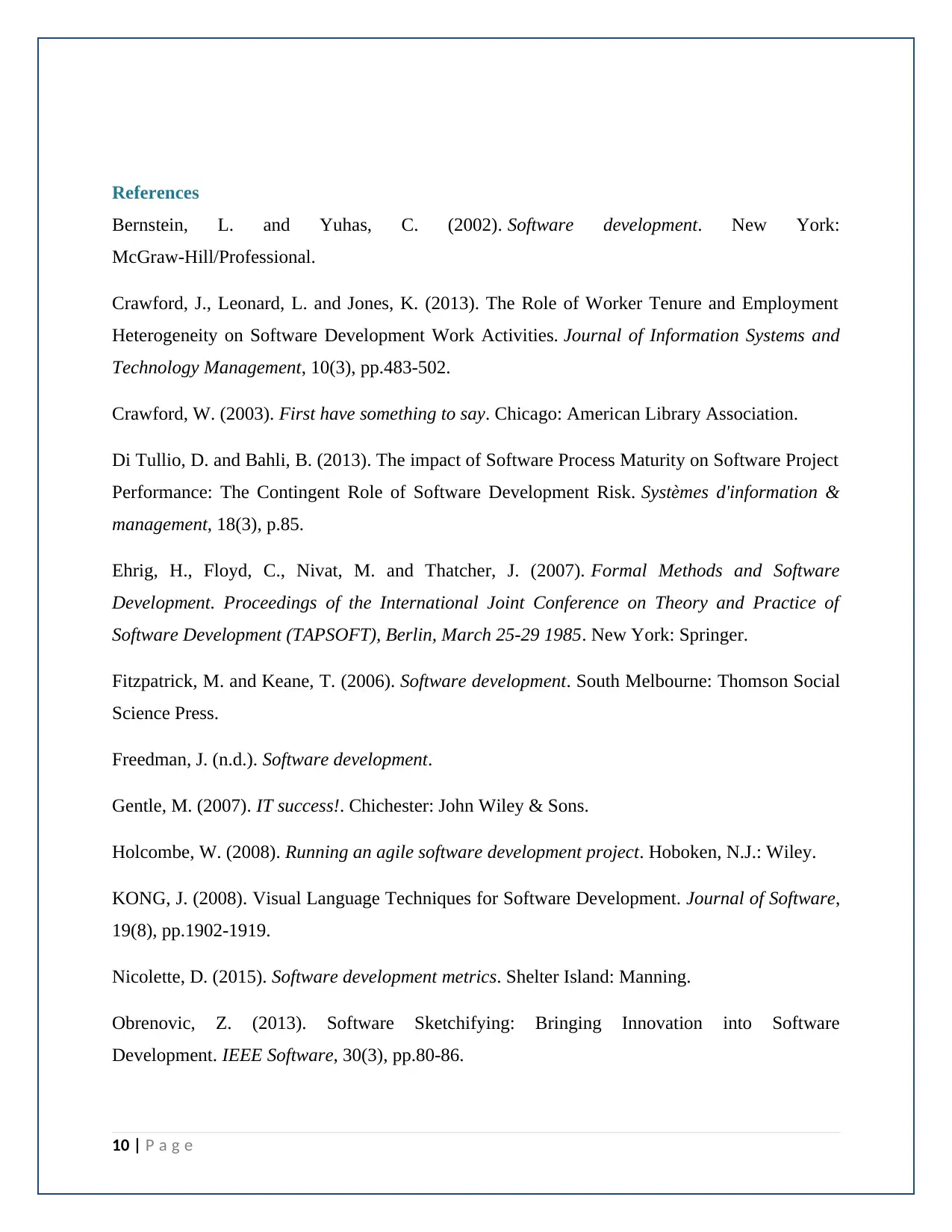
References
Bernstein, L. and Yuhas, C. (2002). Software development. New York:
McGraw-Hill/Professional.
Crawford, J., Leonard, L. and Jones, K. (2013). The Role of Worker Tenure and Employment
Heterogeneity on Software Development Work Activities. Journal of Information Systems and
Technology Management, 10(3), pp.483-502.
Crawford, W. (2003). First have something to say. Chicago: American Library Association.
Di Tullio, D. and Bahli, B. (2013). The impact of Software Process Maturity on Software Project
Performance: The Contingent Role of Software Development Risk. Systèmes d'information &
management, 18(3), p.85.
Ehrig, H., Floyd, C., Nivat, M. and Thatcher, J. (2007). Formal Methods and Software
Development. Proceedings of the International Joint Conference on Theory and Practice of
Software Development (TAPSOFT), Berlin, March 25-29 1985. New York: Springer.
Fitzpatrick, M. and Keane, T. (2006). Software development. South Melbourne: Thomson Social
Science Press.
Freedman, J. (n.d.). Software development.
Gentle, M. (2007). IT success!. Chichester: John Wiley & Sons.
Holcombe, W. (2008). Running an agile software development project. Hoboken, N.J.: Wiley.
KONG, J. (2008). Visual Language Techniques for Software Development. Journal of Software,
19(8), pp.1902-1919.
Nicolette, D. (2015). Software development metrics. Shelter Island: Manning.
Obrenovic, Z. (2013). Software Sketchifying: Bringing Innovation into Software
Development. IEEE Software, 30(3), pp.80-86.
10 | P a g e
Bernstein, L. and Yuhas, C. (2002). Software development. New York:
McGraw-Hill/Professional.
Crawford, J., Leonard, L. and Jones, K. (2013). The Role of Worker Tenure and Employment
Heterogeneity on Software Development Work Activities. Journal of Information Systems and
Technology Management, 10(3), pp.483-502.
Crawford, W. (2003). First have something to say. Chicago: American Library Association.
Di Tullio, D. and Bahli, B. (2013). The impact of Software Process Maturity on Software Project
Performance: The Contingent Role of Software Development Risk. Systèmes d'information &
management, 18(3), p.85.
Ehrig, H., Floyd, C., Nivat, M. and Thatcher, J. (2007). Formal Methods and Software
Development. Proceedings of the International Joint Conference on Theory and Practice of
Software Development (TAPSOFT), Berlin, March 25-29 1985. New York: Springer.
Fitzpatrick, M. and Keane, T. (2006). Software development. South Melbourne: Thomson Social
Science Press.
Freedman, J. (n.d.). Software development.
Gentle, M. (2007). IT success!. Chichester: John Wiley & Sons.
Holcombe, W. (2008). Running an agile software development project. Hoboken, N.J.: Wiley.
KONG, J. (2008). Visual Language Techniques for Software Development. Journal of Software,
19(8), pp.1902-1919.
Nicolette, D. (2015). Software development metrics. Shelter Island: Manning.
Obrenovic, Z. (2013). Software Sketchifying: Bringing Innovation into Software
Development. IEEE Software, 30(3), pp.80-86.
10 | P a g e
Paraphrase This Document
Need a fresh take? Get an instant paraphrase of this document with our AI Paraphraser
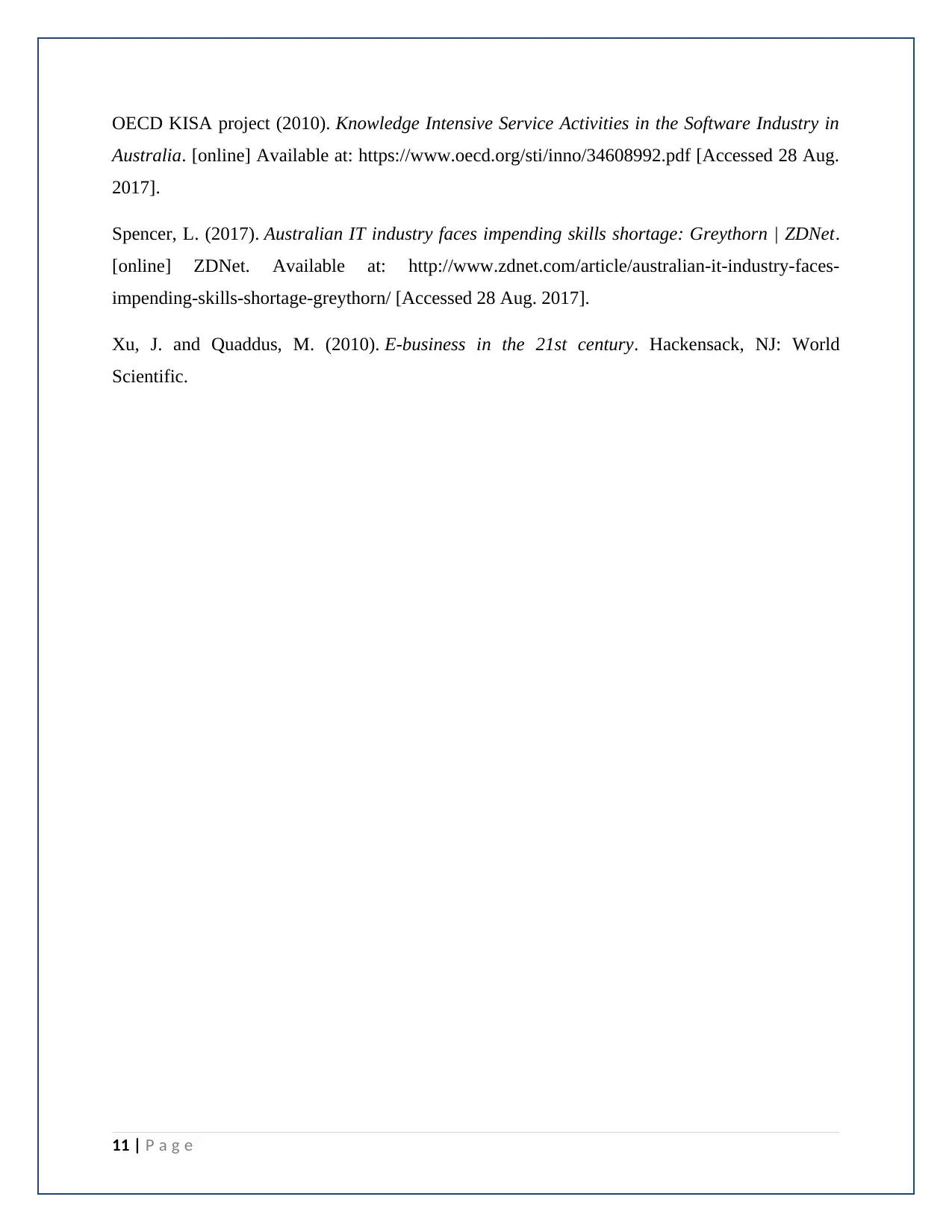
OECD KISA project (2010). Knowledge Intensive Service Activities in the Software Industry in
Australia. [online] Available at: https://www.oecd.org/sti/inno/34608992.pdf [Accessed 28 Aug.
2017].
Spencer, L. (2017). Australian IT industry faces impending skills shortage: Greythorn | ZDNet.
[online] ZDNet. Available at: http://www.zdnet.com/article/australian-it-industry-faces-
impending-skills-shortage-greythorn/ [Accessed 28 Aug. 2017].
Xu, J. and Quaddus, M. (2010). E-business in the 21st century. Hackensack, NJ: World
Scientific.
11 | P a g e
Australia. [online] Available at: https://www.oecd.org/sti/inno/34608992.pdf [Accessed 28 Aug.
2017].
Spencer, L. (2017). Australian IT industry faces impending skills shortage: Greythorn | ZDNet.
[online] ZDNet. Available at: http://www.zdnet.com/article/australian-it-industry-faces-
impending-skills-shortage-greythorn/ [Accessed 28 Aug. 2017].
Xu, J. and Quaddus, M. (2010). E-business in the 21st century. Hackensack, NJ: World
Scientific.
11 | P a g e
1 out of 11
Your All-in-One AI-Powered Toolkit for Academic Success.
+13062052269
info@desklib.com
Available 24*7 on WhatsApp / Email
![[object Object]](/_next/static/media/star-bottom.7253800d.svg)
Unlock your academic potential
Copyright © 2020–2025 A2Z Services. All Rights Reserved. Developed and managed by ZUCOL.
